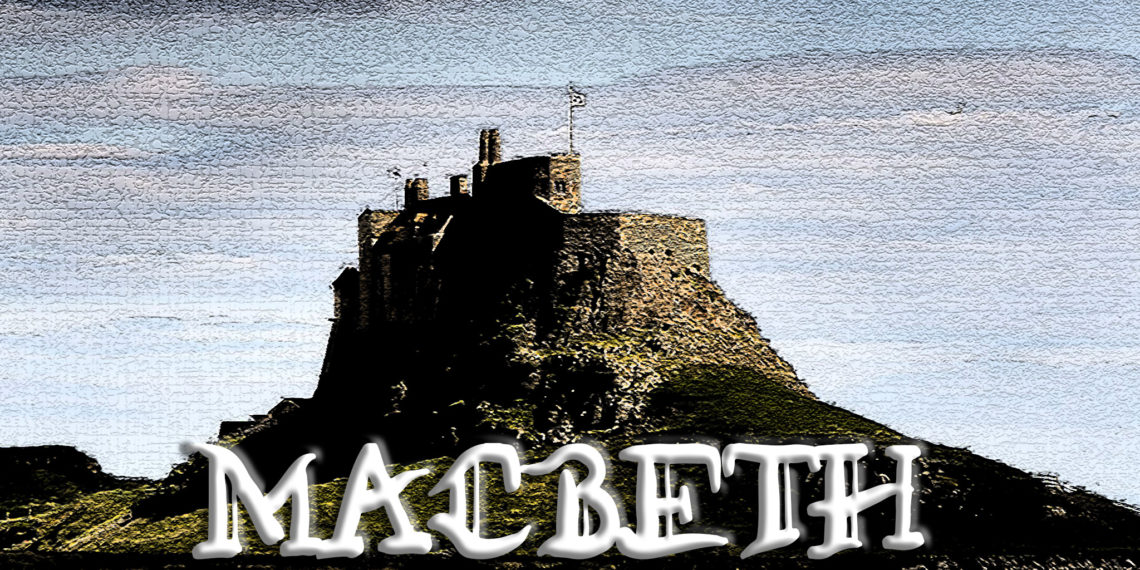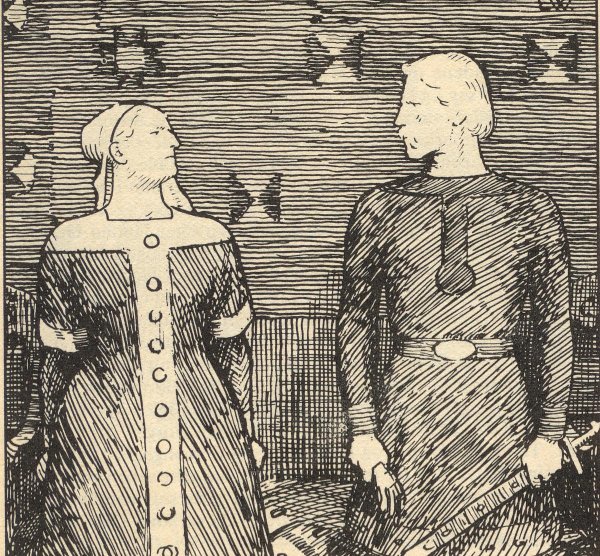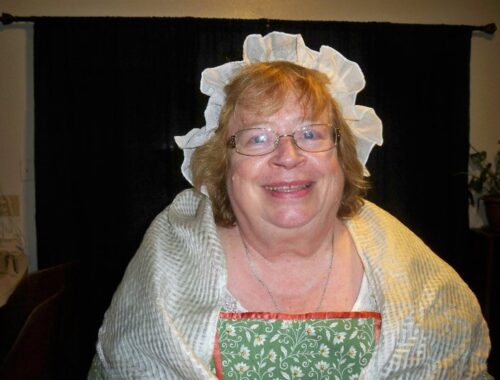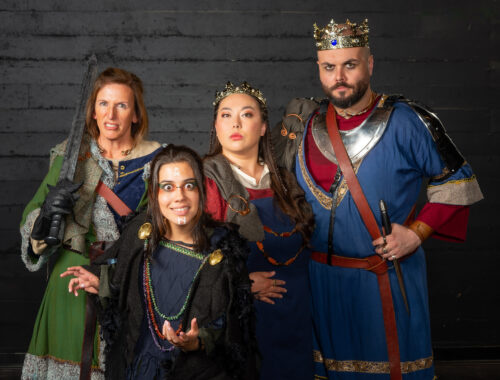
The Warriors of Macbeth
Dramaturgical research provided by Lauren Ormond
Macbeth opens July 7 and runs through July 23. Tickets available.
Dramaturgical research helps directors provide context for an existing play. Dramaturgs look into many aspects of the play’s creation, first productions, time periods expressed, and more. For example, when researching a play like “Macbeth,” there are many avenues to pursue. Research areas may include:
- Shakespeare and his time
- Macbeth’s time
- Traditions of the culture the play
- Expanded themes outside of the time it was written or originally set in
- Clothing
- Music
- Art
- Food
- and the list goes on.
Each dramaturg takes their own approach with guidance from the director(s). Our dramaturg, Lauren Ormond, has worked on multiple shows with us now and provides wonderful research for us to build our world on. One of the questions we asked her early on was how to incorporate more female identifying actors in our cast by researching the roles of women in the time we are setting the play.
Our play is set roughly around 1263 in Northern (modern day) Scotland. At this time, there has been over 400 of Viking warfare with the locals. Viking culture had seeped into many aspects of Scottish life, so much so that over 1,000,000 Scots today have Viking DNA, and many town or village names are still Nordic.
Lauren found some amazing information on the women warriors of both cultures. It’s a lot of information, and incredibly fascinating.
Female Warriors Scotland High Middle Ages (900 – 1286 CE)
- SCÁTHACH, TRAINER OF HEROES
- Known as “The Shadowy One” “Warrior Maid”
- Mythology figure seen in 10th century Tochmarc Emire (Wooing of Emer) a legend of the Ulster Cycle in Irish mythology dating to the 10th century
- A Scottish female warrior and teacher of warriors in Celtic mythology
- Lived on an island (thought to be the Isle of Skye) in an impregnable castle, the gate of which was guarded by her daughter Uathach
- Scáthach trained numerous Celtic heroes in the arts of pole vaulting (useful in the assault of forts), underwater fighting, and combat with a barbed harpoon of her own invention, the gáe bolg. Her best-known student was Cú Chulainn, who stayed with her for a year in order to learn the skills that helped him win many battles
- Scottish Island of Eigg
- Roughly translates to “Island of the Big Women”
- Archaeological remains show a group of people known as the Picts resided there and in other parts of Scotland up until the ninth century
- Pictish texts and engravings detail legends of warrior women
- One specific legend details a clan of warrior women residing on An Sgùrr, Eigg’s highest hill
- Pictish Women Warriors
- Engravings from the 1500s based on Roman records describe the Roman army’s encounters with the Picts, and represent both men and women as scantily clad and tattooed warriors
- Engravings of warriors riding side saddle point to the existence of Pictish female warriors
- Scotland in the Middle Ages, like most settings of that time period, was a patriarchal society, and women warriors were not something commonly seen save for desperate moments in history
Female Viking Warriors High Middle Ages (900 – 1286 CE)
- Though the Viking society of the High Middle Ages shows women sharing equal rights with men (they could own land, initiate divorce, serve as clergy, and run their own businesses), their sphere of influence was largely domestic. However, Norse mythology has a great many instances of depicting women joining battle alongside their male counterparts
- These women are described either in the Icelandic sagas of the 12th and 13th centuries CE, in the work of Snorri Sturluson (1179-1241 CE) – an Icelandic mythographer who wrote down and preserved earlier Norse works which had been transmitted orally – or in the historical and semi-historical works of other writers such as the Dane Saxo Grammaticus (c. 1160-c. 1220 CE)
- The most famous type of mortal warrior woman known from the sagas is the shieldmaiden, a woman who took up arms and armor and fought in battle alongside men and who is mirrored in the spiritual realm of the afterlife by the Valkyries
- A real life example of a shield woman was first recovered in 1900 on a farm in Solør Norway, an 18-19 year old girl having been buried with her head resting on a shield, a bridled horse skeleton lay curled at her feet, and her body boxed in by a sword, spear, battle-ax and arrows
- She was the first Viking woman archaeological find with a notable battle wound, a partially healed skull fracture most likely from a sword that had cut her to the bone
- Another Viking warrior woman uncovered in Birka (a Viking settlement in east central Sweden that flourished from about 750 – 950) in 1878 but not proven to be female until 2017 was buried with with an array of weapons and horses, plus a set of chess-like gaming pieces that suggested a tactical aptitude commensurate with a high-ranking military official, leaning towards the fact that she may have been a general
- Though before the High Middle Ages, the best-known semi mythological account of this comes from Saxo Grammaticus in his description of the Battle of Bråvalla (or Brávellir) (c. 750 CE) in his early 13th-century CE Gesta Danorum where he claims 300 shieldmaidens fought for the Danes
- Skadi: Goddess of hunting and skiing
- After her father was killed by Thor, Skadi, who had no brothers, took it upon herself to avenge her father’s death
- Freyja: Goddess of fertility, love, and luck
- Chooses half the dead in battle to reside in the Field of the People, while Odin takes half for Valhalla
- Brynhild
- A Valkyrie who, after supporting the wrong hero in a contest overseen by Odin, is made mortal and is imprisoned in a castle behind a wall of shields, asleep within a ring of fire, until rescued by the champion Sigurd, though is tricked into believing he has forsaken her and instead marries Gunnar, son of the sorceress and wife of King Gjuki. She murders Sigurd and his young son but, realizing her mistake, throws herself into his funeral pyre and rides with him into Hel
- Lagertha: The victorious shieldmaiden
- A figure within Chapter IX of Saxo Grammaticus’ Gesta Danorum (‘History of the Danes’)
- The legendary hero Ragnar Lothbrok comes to Norway to avenge the death of his grandfather Siward and the humiliation of his wives and kinfolk at the hands of Frø, the King of Sweden. He is greeted by a number of women dressed as men who volunteer to help him
- “…among them was Ladgerda, a skilled female warrior who, though a maiden, had the courage of a man and fought in front among the bravest with her hair loose over her shoulders. All marveled at her matchless deeds, for her locks flying down her back betrayed that she was a woman. . .”
- Ragnar forces Lagertha to marry her after the battle, but later divorces her and marries another woman
- Hervor: Wielder of the magic sword Tyrfing
- Hervor is the heroine of the 13th century CE Hervarar saga ok Heiðreks (The Saga of King Heidrek the Wise)
- Hervor’s father, Angantyr, had a magic sword called Tyrfing but was killed in a duel and the sword was buried with him
- Hervor travels with her crew to the island of Samsø in the Kattegat region where Angantyr is buried and summons his spirit, demanding the sword. Her father’s ghost pleads with her to abandon her quest but she will not be denied. Finally, he opens his grave and gives her the magic sword.
- The sword curses its owner with nothing but trouble, and after several adventures Hervor marries and gives it to her son, who is plagued with its curse, before it is given to his daughter Hevor after his death, and she is shortly thereafter killed in battle
- Freydis Eiríksdóttir: Explorer and defender of her party (born circa 970 – circa 1004 CE)
- Portrayed as both either a great woman warrior (Erik the Red’s Saga) or an evil, conniving murderess (The Saga of the Greenlanders)
- In Erik the Red’s Saga, Freydis, daughter of Erik the Red, accompanies a party to Vinland (Newfoundland, North America). They are attacked by a group of natives and the men of the party retreat, leaving Freydis alone. She calls out to them, “Why run you away from such worthless creatures, stout men that ye are, when, as seems to me likely, you might slaughter them like so many cattle? Let me but have a weapon, I think I could fight better than any of you”
- Though hinted at to be pregnant, Freydis grabs a sword from a dead comrade and, tearing open her shirt and beating her breasts with the blade, defies the enemy who retreat from her, thus saving her party
- In The Saga of the Greenlanders she accompanies her husband, his men, and two brothers/business partners to Vinland. She dislikes the brothers and feels they are too presumptuous so she frames them, telling her husband they abused and beat her and that she will divorce him if he does not avenge the insult. Her husband and his men kill the brothers and their party but will not hurt the women so Freydis kills all the women herself with an axe
- It is likely that this second story, written later than the first, is an attempt to discredit the strong female figure from the earlier saga, and it is very likely that Freyda represents a real woman, given sagas concerning Vinland remembered real people and events
- Gudrid Thorbjarnardóttir: Explorer in North America (Vinland)
- Gudrid Thorbjarnardóttir (born 970/980 CE) was the daughter of Erik the Red and among the earliest explorers of North America, according to both The Saga of the Greenlanders and Erik the Red’s Saga
- After her first husband’s death in Greenland, she remarries Thorstein, younger brother of Leif Erikson, and accompanies them to on their expedition to North America where she explored Vinland with the others in the party
- Thorstein died there and Gudrid returned to Greenland where she married one Thorfinn Karlsefni and, sometime later, returned with him to Vinland to establish a permanent settlement there. Their son, Snorri Thorfinnsson, was the first European child born in North America
- Sigrid the Proud: Ruled on her own, killed her suitors
- (927 – 1014 CE, also known Sigrid the Haughty, Sigríð Storråda, or Sigrid Tostadottir), a Swedish queen
- She was married to Erik the Victorious, king of Sweden (970 – 995 CE), and after his death preferred to reign alone. She was courted by Harald Grenske of Norway and Vissavald of the Kievan Rus but recognized that both were only interested in her for her land and wealth. She invited them to a party where, after they and their men fell asleep from too much drink, she barred the doors of the hall and burned them to death to discourage future suitors
- The infamous Olaf Tryggvason (995 – 1000 CE) who converted the populace of Norway to Christianity through torture, allegedly also sought her hand but insisted she convert to Christianity first. When she refused, he slapped her in public and Sigrid vowed revenge. She is said to have then married Sweyn Forkbeard for his connections and power and orchestrated the Battle of Svolder (1000 CE) in which Olaf was killed
- Unn the Deep-Minded: Settled Iceland, commanded her own fleet
- (9th century CE, also known as Aud the Deep-Minded and Unn or Aud Ketilsdóttir) was the daughter of Ketil Flatnose of Norway who fled to Scotland following the rise of Harald Fairhair in Norway
- When her father and her son Thorstein died she understood her position in Scotland was precarious and went first to the Orkneys in the north and then to Iceland which she explored before settling down. She commanded a crew of men who were so loyal to her that none would enter into marriage contracts which might jeopardize Unn’s property or power




The Verse is Yet to Come
You May Also Like

CELEBRATION OF LIFE FOR LENORE JUSTMAN
March 3, 2024
My Make-Up Journey to Witch 1
July 2, 2023
